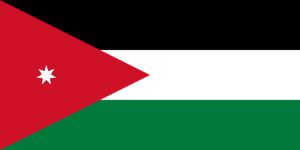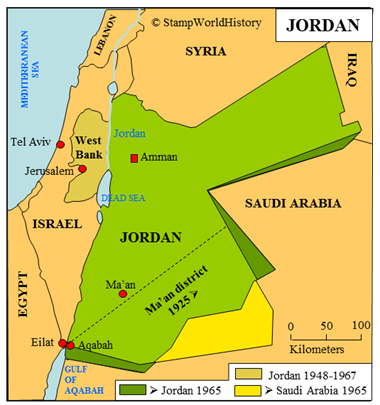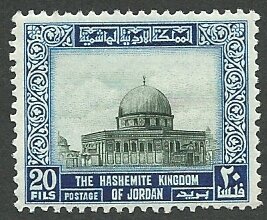الأردن

Jordan
Quick reference
General issues: Transjordan/British administration 1920-1922, Transjordan/British mandated territory 1922-1946, Transjordan/Kingdom 1946-1949, Jordan/Kingdom 1949-Present
Country name on general issues: ‘East of Jordan’ in Arabic, ‘Arab Government of the East’ in Arabic, Transjordan, Jordan
Special issues: Occupation of the Palestine 1948-1950
Currency: 1 Pound = 100 Piaster = 1000 Millièmes 1920-1927, 1 Pound = 1000 Milièmese 1927-1950, 1 Dinar = 1000 Fils 1950-Present
Population: 675 000 in 1920, 6 459 000 in 2013
Political history Jordan
Jordan is located in the Middle East in western Asia. In the 19th century Jordan is part of the Ottoman Empire, governed as part of the Hejaz and Syria vilayets[1]Ottoman provinces. . When the Ottoman Empire sides with the Central Powers[2]Germany, Austria-Hungary and their allies in WWI, the Allies invade the Ottoman Empire in the Middle East. Jordan is occupied in part by Arabian forces and in part by the British ‘Egyptian Expeditionary Force’. As the Ottoman Empire is subsequently divided, the newly formed kingdoms of Hejaz and Syria both claim Jordan. However, the British and the French have already agreed on how to divide the Middle East among themselves. As of 1920, Jordan, or Transjordan as it is then called, is put under British administration. In 1922, the League of Nations formally awards Transjordan to Britain as a mandated territory. A mandate that lasts until 1946.
Under British rule, in 1921 the emirate of Transjordan is established with the Hashemites as the ruling family. In two steps, in 1923 and 1927, Transjordan gains a significant amount of self government. When the British mandate ends in 1946, Transjordan gains full independence as the kingdom of Transjordan. In 1949, the name is changed to Jordan, in full: the Hashemite kingdom of Jordan.
The borders of Jordan are, in part, determined in the agreements between France and Great Britain on their spheres of influence in the Middle East. In part, the borders have yet to be determined. In 1925, the borders with the predecessors of Saudi Arabia – the kingdom of Hejaz and the emirate of Nejd – are agreed upon. Transjordan gains the Ma’an district and thus strategic access to the Red sea. In 1965, the borders are adjusted in a further agreement with Saudi Arabia. Jordan gains a wider access to the Red Sea around Aqabah in exchange for territory inland that is ceded to Saudi Arabia.

Petra
In the second part of the 20th century Jordan is one of the key players in the Arab-Israeli conflict. Jordan is one of the countries declaring war upon Israel, in 1948, right after the foundation of the state of Israel. Jordan occupies what has become known as the West Bank and annexes this territory in 1950, until, during the Six Day War in 1967, the West Bank is occupied by Israel. During the subsequent wars with Israel, many Palestinians have sought refuge in Jordan. When they are perceived to be a threat for the ruling establishment in Jordan, the Palestinians are evicted from the country in 1970, many now moving to Lebanon. In the 1973 Yom Kippur War with Israel Jordan has a limited role. Jordan, in 1994, signs a peace agreement with Israel. Through this agreement Jordan relinquishes its claims on the West Bank, that now becomes part of the negotiations for an independent Palestinian state.
Jordan is one of the less developed Middle East countries, lacking oil resources. In recent years the ‘Arab Spring’ has seemed to bypass Jordan, although Jordanians do press for further political liberalization and economic reforms.
Postal history Jordan
When under Ottoman rule, only very limited postal services exist in Jordan. When Britain occupies the territory during WWI, initially the issues from the Egyptian Expeditionary Force, inscribed ‘E.E.F.’, are used – as they are in other countries in the Middle East under British occupation. These issues are commonly listed with Palestine. When under British civil administration, stamps are issued in 1920, these the E.E.F. issues with an overprint reading ‘East of Jordan’ in Arabic, referring to the territory lying east of the river Jordan. Once the emirate has been formed, as of 1922, overprints are issued reading ‘Arab Government of the East’. The first definitives are issued in 1927 now inscribed ‘Transjordan’. These are superseded by the issues of the kingdom of Transjordan in 1946 and those of the kingdom of Jordan in 1949.
When it has occupied the West Bank in Palestine in 1948, Jordan issues stamps for use in the occupied territory, these being Jordanian issues overprinted ‘Palestine’ in Arabic and in English. When Jordan annexes the West Bank in 1950 these are withdrawn to be succeeded by the general issues from Jordan that will be used on the West Bank until it is occupied by Israel in 1967.
Album pages
← Previous page: JapanNext page: Kazakhstan →






